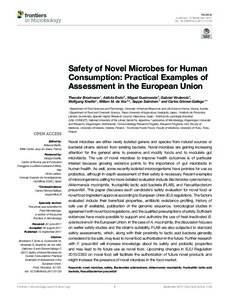| dc.contributor.author | Gueimonde M | |
| dc.contributor.author | Brodmann T | |
| dc.contributor.author | Gomez-Gallego C | |
| dc.contributor.author | Kneifel W | |
| dc.contributor.author | Salminen S | |
| dc.contributor.author | de Vos WM | |
| dc.contributor.author | Endo A | |
| dc.contributor.author | Vinderola G | |
| dc.date.accessioned | 2022-10-28T14:38:02Z | |
| dc.date.available | 2022-10-28T14:38:02Z | |
| dc.identifier.uri | https://www.utupub.fi/handle/10024/172478 | |
| dc.description.abstract | Novel microbes are either newly isolated genera and species from natural sources or bacterial strains derived from existing bacteria. Novel microbes are gaining increasing attention for the general aims to preserve and modify foods and to modulate gut microbiota. The use of novel microbes to improve health outcomes is of particular interest because growing evidence points to the importance of gut microbiota in human health. As well, some recently isolated microorganisms have promise for use as probiotics, although in-depth assessment of their safety is necessary. Recent examples of microorganisms calling for more detailed evaluation include Bacteroides xylanisolvens, Akkermansia muciniphila, fructophilic lactic acid bacteria (FLAB), and Faecalibacterium prausnitzii. This paper discusses each candidate's safety evaluation for novel food or novel food ingredient approval according to European Union (EU) regulations. The factors evaluated include their beneficial properties, antibiotic resistance profiling, history of safe use (if available), publication of the genomic sequence, toxicological studies in agreement with novel food regulations, and the qualified presumptions of safety. Sufficient evidences have made possible to support and authorize the use of heat-inactivated B. xylanisolvens in the European Union. In the case of A. muciniphila, the discussion focuses on earlier safety studies and the strain's suitability. FLAB are also subjected to standard safety assessments, which, along with their proximity to lactic acid bacteria generally considered to be safe, may lead to novel food authorization in the future. Further research with F. prausnitzii will increase knowledge about its safety and probiotic properties and may lead to its future use as novel food. Upcoming changes in EUU Regulation 2015/2283 on novel food will facilitate the authorization of future novel products and might increase the presence of novel microbes in the food market. | |
| dc.language.iso | en | |
| dc.publisher | FRONTIERS MEDIA SA | |
| dc.title | Safety of Novel Microbes for Human Consumption: Practical Examples of Assessment in the European Union | |
| dc.identifier.urn | URN:NBN:fi-fe2021042717237 | |
| dc.relation.volume | 8 | |
| dc.contributor.organization | fi=funktion. elint. kehittämiskeskus (yhteiset)|en=Functional Foods Forum| | |
| dc.contributor.organization-code | 2607020 | |
| dc.converis.publication-id | 26868924 | |
| dc.converis.url | https://research.utu.fi/converis/portal/Publication/26868924 | |
| dc.identifier.eissn | 1664-302X | |
| dc.identifier.jour-issn | 1664-302X | |
| dc.okm.affiliatedauthor | Salminen, Seppo | |
| dc.okm.affiliatedauthor | Gomez Gallego, Carlos | |
| dc.okm.discipline | 1183 Plant biology, microbiology, virology | en_GB |
| dc.okm.discipline | 1183 Kasvibiologia, mikrobiologia, virologia | fi_FI |
| dc.okm.internationalcopublication | international co-publication | |
| dc.okm.internationality | International publication | |
| dc.okm.type | A2 Review article | |
| dc.publisher.country | Switzerland | en_GB |
| dc.publisher.country | Sveitsi | fi_FI |
| dc.publisher.country-code | CH | |
| dc.publisher.place | Lausanne | |
| dc.relation.articlenumber | ARTN 1725 | |
| dc.relation.doi | 10.3389/fmicb.2017.01725 | |
| dc.relation.ispartofjournal | Frontiers in Microbiology | |
| dc.year.issued | 2017 | |
